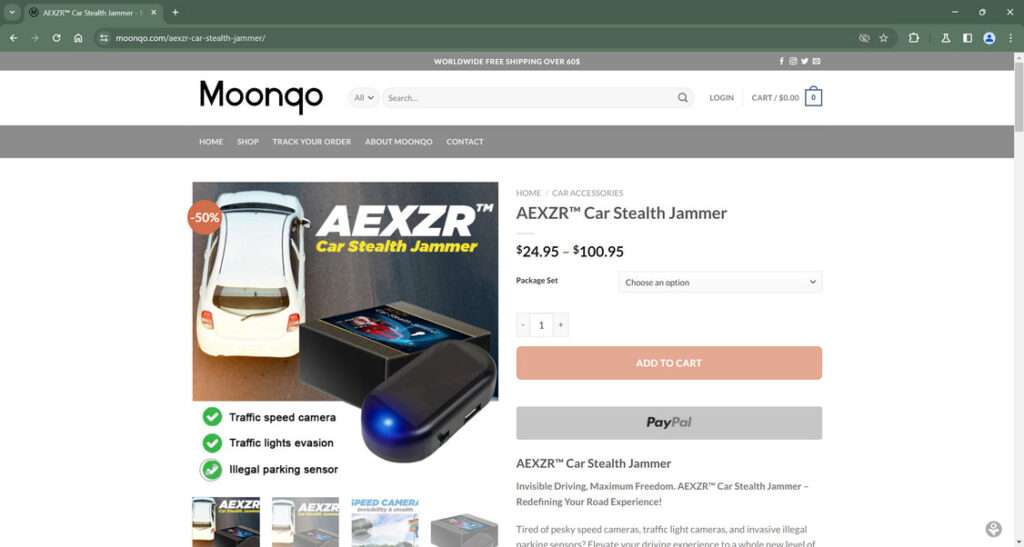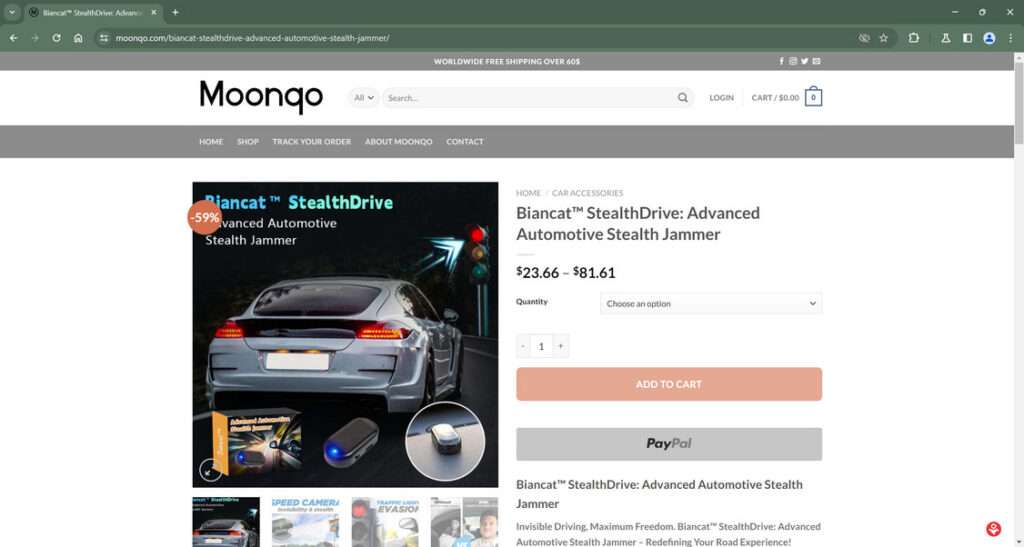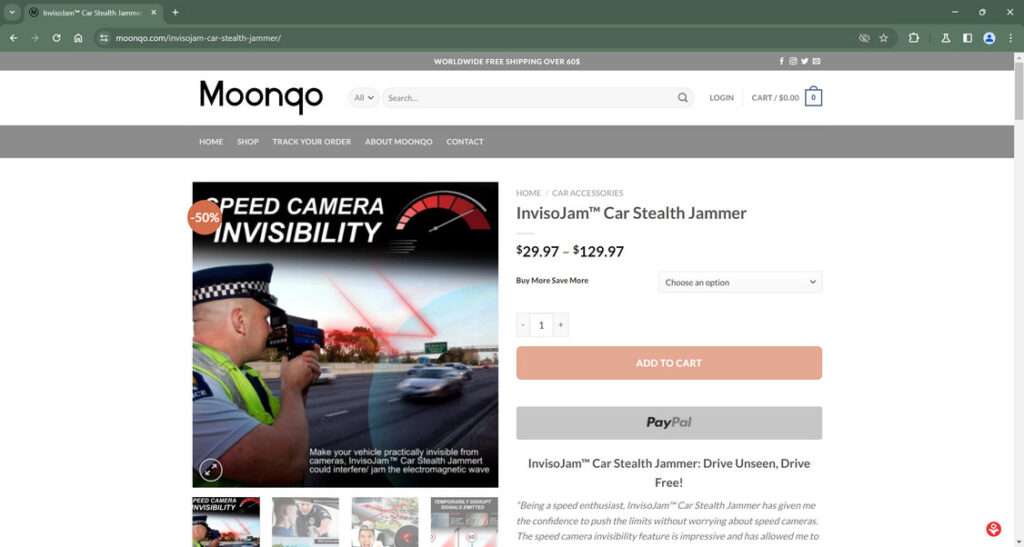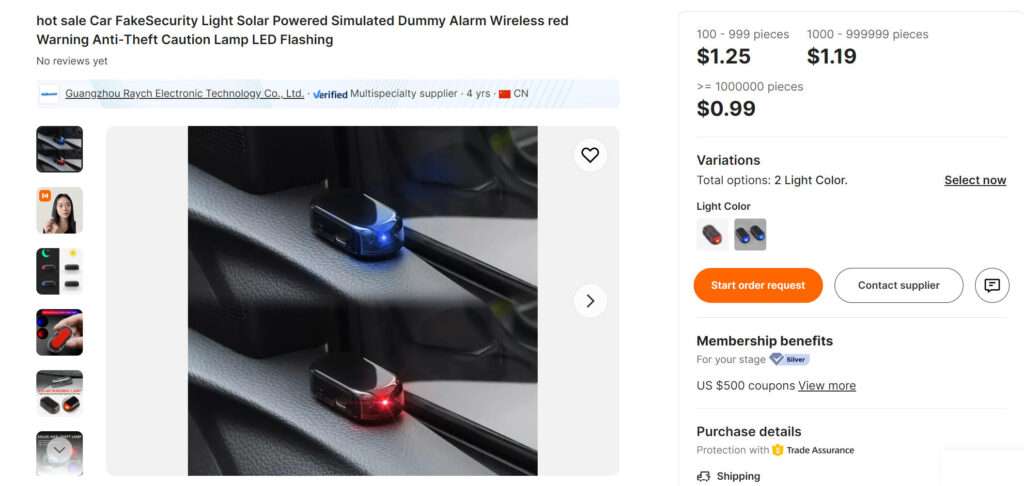Slick advertisements promoting automotive “stealth jammer” innovations are proliferating across social media and inboxes using unbelievable claims of disruptive signal blocking capabilities. However, investigation reveals these overhyped gadgets fail catastrophically to deliver on their bold promises. This article will uncover how this prevalent automotive scam works and provide tips to avoid getting ripped off by fictional products.






An Overview of the Dubious Car Stealth Jammer Scam
The car stealth jammer scam operates through running misleading social media ads and websites promoting $1 novelty items as advanced driver privacy and security gadgets that supposedly utilize exclusive signal jamming and disruption technology highly coveted by those valuing anonymity and freedom from tracking on the road.
But testing of ordered units across brands being labeled using this terminology reveals these marketed capabilities are totally fabricated. The actual devices shipped out are cheap $1 solar-powered red dummy anti-theft lights purchased in bulk from Chinese ecommerce sites and then resold at insane 40-50X markups through blatantly false advertising and made up authority claims.

These scammers bank on convincing language referencing desirable signal scrambling hacks and protections, fake write-ups in consumer digests, and a communicated sense of urgency around limited quantity flash sales to generate impulse purchases before prospective buyers thoroughly vet the illegitimate pop-up websites and companies behind the ads. Refunds are notably difficult or outright impossible to obtain after the near-worthless $1 red flashing novelty lights inevitably fail to perform any actual signal blocking as promised to disrupt GPS, traffic cameras, parking sensors and more.
Read on for a detailed playbook on how this egregious rebranded automotive scam manages to secure lucrative payments upfront for cheap solar-powered Chinese imports by relying on fabricated claims and snazzy yet unrealistic depictions across scammy blog posts and manipulated video demonstrations. Prevention starts with recognition of deception tactics used to market these illusionary automotive privacy solutions.
Scammers Rebrand the Same $1 Device Under Various Names
It’s important to note that this signal disruption automotive scam constantly resurfaces under new fictional company names and product brands to avoid easy connections back to previously exposed operations by defrauded customers.
Some other brand names that pop-up social media ads have promoted through unbelievable claims of disrupting external vehicle signals and preventing fines include Aexzr Car Stealth Jammer, InvisoJam Car Stealth Jammer Device, Lyseemin Car Stealth Jammer, Bikenda Car Stealth Jammer, Biancat StealthDrive, and iRosesilk 5G Car Stealth Jammer among other branding tactics.






However, despite the different names and ever-evolving origin stories, the devices behind all these brands are exactly the same – $1 anti-theft dummy lights ordered in bulk from Chinese wholesale websites then resold through fabricated claims and manipulated media to overcharge consumers unfamiliar with real automotive privacy and security accessories.
So drivers must beware these routinely rebranded scams promoting cheap novelty items as must-have high-tech automotive innovations through unbelievable claims across slick marketing campaigns. A small flashing red light simply cannot disrupt signals or prevent fines regardless of terminology used.
How Car Stealth Jammer Scammers Deceive
While using different branding, the bait-and-switch process these automotive stealth jammer scams follow to overcharge using unbelievable claims exposed as false upon delivery remains largely the same. Here’s an in-depth look:
Phase 1: Portraying $1 Novelties as Signal Blocking Innovations
The scam starts by depicting bottom barrel items as remarkable innovations drivers must have. Compelling social media ads on platforms like Facebook, Instagram and TikTok portray the $1 Chinese imports using mind-blowing claims of disrupting signals from GPS, traffic cameras, parking sensors and more through exclusive advanced technology.
Some examples of the clearly impossible capabilities touted include:
- “Blocks GPS signals so private investigators cannot monitor your location without consent”
- “Jams nearby traffic cameras and obscure your license plate number from automated ticketing”
- “Prevents parking sensors from citing your vehicle allowing unlimited unpaid street parking”
- “Selectively manipulates traffic signals to safely go through red lights without camera penalties”
The exaggerated terminology is meant to entice those coveting enhanced automotive privacy by portraying cheap flashing lights as elusive unravelers of secret tracking techniques allegedly exploited without driver permission by opaque organizations.
Phase 2: Drowning Out Research to Push Overpayment
After luring social media visitors, secondary pages at the shady sales domains utilize additional tricks to prevent research while pushing lump purchases of the marked up devices. These include:
- More outlandish staged depictions of supposed GPS blocking, automated traffic enforcement evasion abilities activated
- Completely fabricated consumer comments and industry expert write-ups endorsing the unrealistic products
- Fake it-could-disappear-any-minute limited supply constraints trying to enable reactionary herd mentality without thought
- Zero ways to ask impartial questions or view unmoderated negative feedback on true device effectiveness
- No company information, address history or guaranteed contact methods provided anywhere
The key goal of fabricated scarcity marketing, referral social proof, countdown urgency tactics, and selective curation of unrealistic praise is to limit level-headed product analysis in favor of emotional response purchasing.
Phase 3: Disappearing After Taking Payment
Unfortunately most consumers soon realize it’s an intentional overcharging scam after the $1 novelty lights arrive and obviously lack any actual ability to actively block external automobile signals crucial to operating safely and legally on roadways. Requested refunds often go ignored or rejected, including:
- Support email and phone inquiries getting only automated no reply responses or disconnected numbers
- Refusals due to supposed expiration of unreasonable brief return authorization windows
- Rejected credit card disputes using phony shipping information submitted at time of fraudulent payment processing
- Forced “exchanges” for identical $1 red flashing dummy toys rather than payment reversals back
This pattern shows the operators behind the fake product claims have zero intent on providing real customer service despite promoting themselves as reputable automotive accessory dealers online initially. Without accountability, these swindlers move on to the next target.
What To Do If You Purchased an Automotive Stealth Jammer Device
If you unfortunately already ordered one of these overhyped $1 novelty lights paraded as high demand privacy gadgets, follow these steps:
1. Dispute charges right away as fraudulent: Contact your card provider immediately to request a chargeback refund by reporting egregiously falsified product claims.
2. Gather illustrative evidence: Take photos of the cheap flashing item shipped clearly lacking any internal technology or capabilities able to actively disrupt external vehicle signals as promoted.
3. Submit scam reports: File complaints about the intentionally misleading products and deceitful business practices to the FTC, state consumer protection divisions, RipOff Report and scam reporting sites.
4. Leave online reviews: Kindly warn others considering purchase by documenting the fake claims versus reality across impartial review sites and social networks. Spread awareness to help curb these scams.
5. Escalate matters with your bank: If chargebacks get unexpectedly denied, firmly request arbitration forcing refund issuance over such an obviously scammy sham automotive product through a final ruling.
With diligence and persistence, numerous victims successfully compel adverse charge revocations from banks against companies intentionally overcharging for falsified products by following these steps immediately after delivery. But avoidance from the start remains the ultimate protection.
How To Recognize Car Stealth Jammer Scams Emerging Online
Here are some key indicators to spot questionable and unrealistic stealth jammer ads as this automotive scam constantly resurfaces:
- Unbelievable privacy promises – Be skeptical of grandiose car accessories pushing more anonymity through disrupting widely adopted public systems via hacking. If the solution sounds too incredible yet simple, it assuredly is.
- Fabricated authority associations – Watch for questionable claims around renowned industry media coverage, elite expert endorsements and safety testing validations that all appear astounding yet have no impartial verifications or concrete attribution details.
- Rehashed products – These scams constantly respawn under new names once exposed. Reverse image search gadget photos and search for recent scam warnings on automotive gear making identical too-good-to-be-true privacy promises across ever-evolving advertisements.
Regular awareness checks on item capabilities claimed versus mechanics known, impartial validation of seller reputations, and proactive internet searches assessing latest online fraud detect and avoid overpayment scams. Verify device functions through objective engineers rather than impulse reactions to compelling claims alone. If an automotive offer seems unbelievable, validate capabilities though professional third party assessment rather than herd-mentality purchase urges. Your ultimate protection is proactive precaution.
Frequently Asked Questions About Misleading Automotive Stealth Jammers
Slick ads promoting automotive stealth jammers are proliferating online using unbelievable claims. This FAQ answers key questions about this prevalent driver privacy gear scam.
What exactly is the car stealth jammer scam?
The car stealth jammer scam uses viral ads and websites with impossible claims of blocking signals to promote $1 novelty lights from China at insane 40-50X markups as must-have privacy accessories. But these outrageous capabilities are outright lies.
How are car stealth jammers generally advertised online?
Scammers run Facebook ads, Instagram influencer promotions and YouTube reviews depicting the $1 novelty items as automotive innovations using exclusive technology to disrupt GPS tracking, nearby traffic cameras, parking violation sensors and other signals. But it’s pure fabrication.
What misleading signal blocking claims do the car stealth jammer ads make?
Some clearly impossible capabilities claimed include scrambling GPS monitoring systems, blocking speed trap traffic cameras, disabling parking violation sensors, hacking red light camera evidence, and leveraging advanced proprietary vehicle signal jamming technology. But it’s a $1 light.
Where do the fraudulent ads funnel victims who click on them?
The fake social media ads send victims to shady websites packed with more manipulated media demonstrations showing supposed signal blocking, fake discounts and reviews, and aggressive upselling urging purchase before fake timers run out.
What transpires for victims after they purchase the hyped products?
Many report the sellers instantly disappearing after taking payment, leaving no way to contact them when the $1 novelty item arrives lacking any actual ability to actively block GPS tracking, obscure traffic cameras, disrupt parking sensors or otherwise manipulate external vehicle signals.
What indicates an automotive privacy gadget promoted through a scam?
Red flags include unbelievable capabilities claimed, using manipulated media demonstrating them, no company address provided, refusing refunds, deleting negative comments, and having no way to contact the seller after purchase to issue complaints.
What should drivers do if they realize purchased automotive gear is falsified?
Immediately file a credit card chargeback disputing the charges as fraudulent over an obviously scammy falsified product, provide documentation proving false marketing, then submit detailed scam complaints to appropriate consumer protection agencies.
Hopefully this FAQ helps drivers avoid and recover from these egregious automotive scams by recognizing exaggerated claims, manipulation tactics and questionable lack of seller accountability as red flags.
The Bottom Line on the Car Stealth Jammer Scam
In summary, key facts to remember around these recurring automotive privacy solution overcharging scams include:
- Slick hype-building ads portray cheap novelty items as automotive game-changers using impossible claims
- Deceptive sales pages prevent impartial product analysis while pushing multi-unit orders
- The actual $1 products completely lack any ability to actively disrupt external vehicle signals
- Support avenues like emails and calls go unanswered after payments process
- Check automotive accessory seller reputations and product capabilities carefully pre-purchase
- Contesting intentionally fraudulent charges can recover at least partial refunds later on
Hopefully this exposé helps explain how unbelievable claims and urging rhetoric can be used to excessively overcharge for essentially worthless novelty products on enthusiast platforms. Stay vigilant – if an automotive gadget seems too incredible to be possible, it almost certainly is. Seek professional consultation before purchase over impulse reactions to extraordinary upgrade promises alone. Your best defense remains proactive protection against questionable automotive aftermarket accessory scams ready to separate excited customers from hard-earned dollars.










